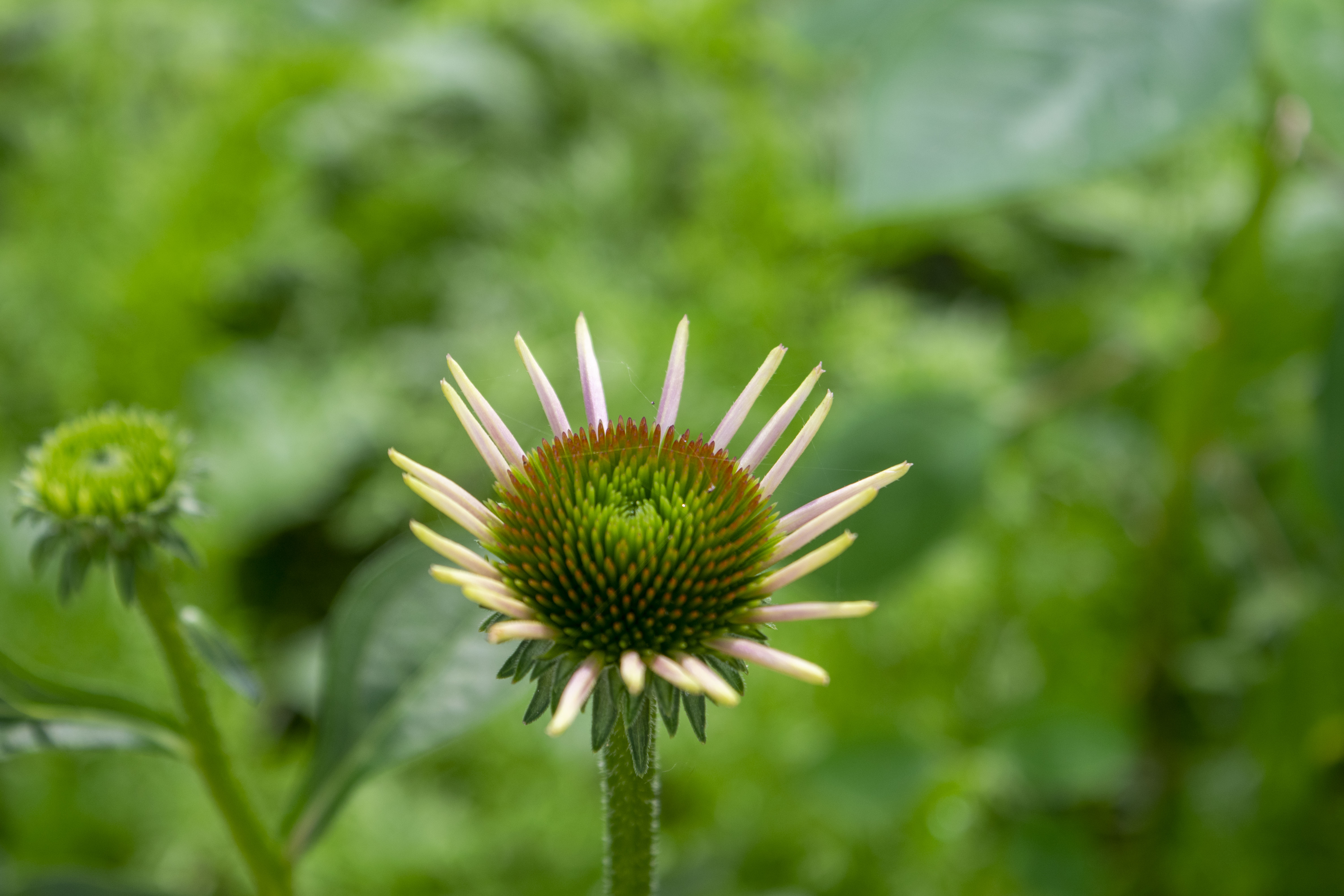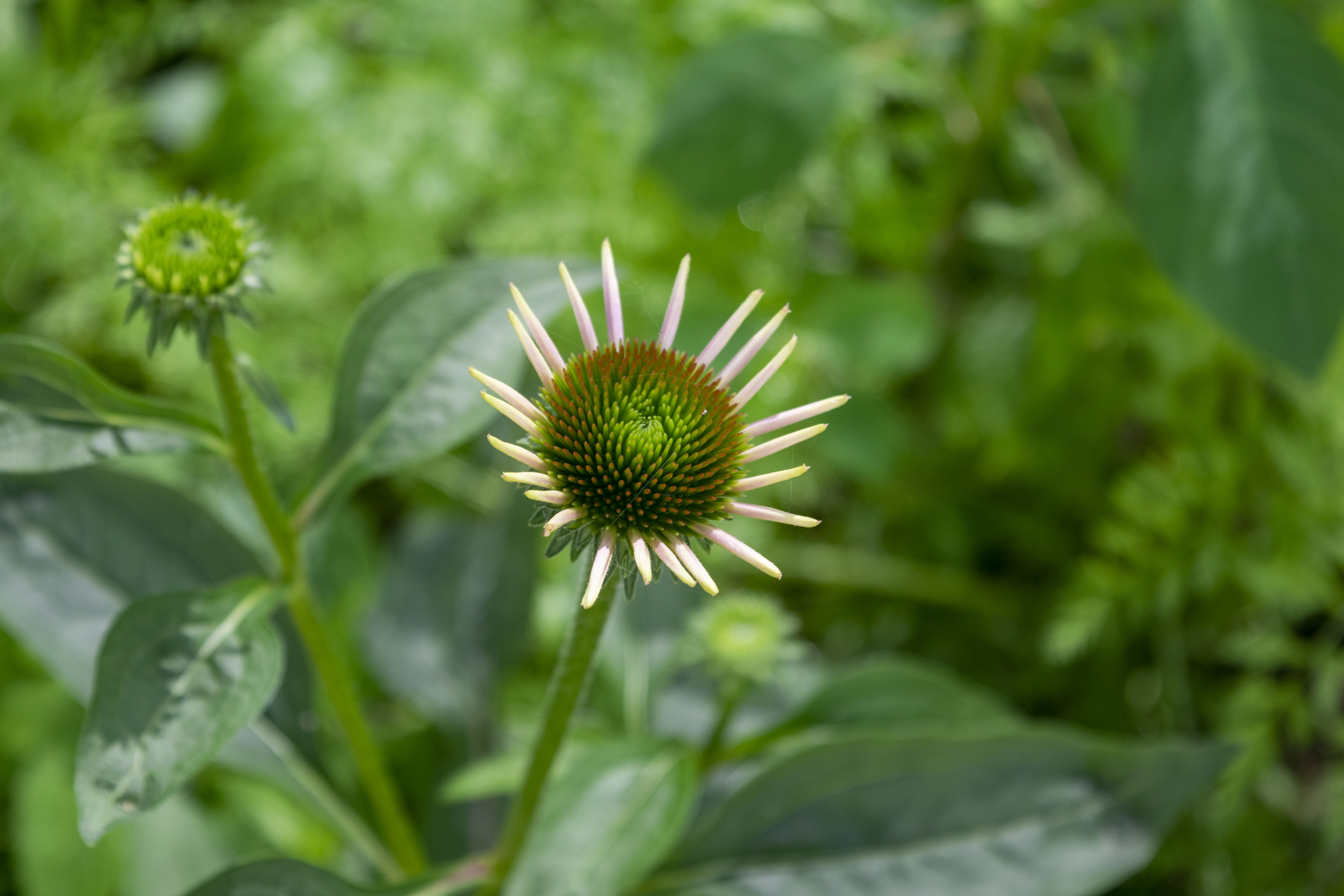ECHINACEA PURPUREA
BOTANICAL DESCRIPTION
Echinacea purpurea (L.) Moench is a robust perennial plant with a well-developed root system and rhizome. It grows 1-1.5 meters tall and has cylindrical roots with brownish-gray exterior and white interior. The plant has branching aerial stems covered in rough hairs and reddish-brown patches. Its linear-lanceolate leaves are 3-6 cm wide. The flowers of Echinacea purpurea are arranged in terminal inflorescences, with pink, pale red, or deep red anthodes. At the base of the inflorescence, there are sharp bracts that lignify and become spiny as they mature. The sterile ray flowers are located at the edge of the inflorescence, with pink ligules that are 5-7 cm long and 0.5 cm wide. The tubular, orange-brown disk flowers are bisexual and situated inside the inflorescence. The fruits are achenes, white-gray in color, with four edges and teeth at the top. Echinacea purpurea blooms during June and July.
TAXONOMY
Order: Asterales
Family: Asteraceae
Genus: Echinacea
Species: purpurea
Botanical Name: Echinacea purpurea
COMMON NAMES
Purple coneflower, Hedgehog coneflower, Echinacae.
LOCAL NAMES
Nil
SYNONYMS
Rudbeckia purpurea, Helichroa purpurea (L.) Raf, Brauneria purpurea (L) Britton, Echinacea intermedia Lindle. ex Paxton.
PHYTOCHEMICALS SCREENING
Echinacea species contain various bioactive compounds. Alkamides, found in the roots, leaves, and flowers, have immunomodulatory and anti-inflammatory effects, interacting with CB2 receptors to influence immune responses. Polysaccharides like arabinogalactans and heteroxylans boost immune functions and antiviral activity. Caffeic acid derivatives, such as cichoric acid and echinacoside, offer antioxidant and immunostimulatory properties. Flavonoids, like quercetin and rutin, contribute anti-inflammatory effects. Essential oils, rich in terpenes and sesquiterpenes, provide antibacterial qualities.
ETHNOBOTANICAL USES
Before European medicines, Echinacea species were widely used on the American plains to treat respiratory infections (colds, flu, bronchitis), urinary tract infections (herpes, gonorrhea), and skin disorders (staph infections, ulcers, wounds, burns, eczema, allergies).
CHEMICAL STRUCTURE
PHARMACOLOGICAL ACTIVITIES
ANTIVIRAL ACTIVITY
Echinacea purpurea has strong antiviral properties and can inactivate a range of viruses, including those causing common colds and influenza. Echinaforce, a standardized extract, reduces inflammation by blocking cytokine release and is as effective as oseltamivir (Tamiflu) in treating influenza-like illnesses. Its antiviral substances, including water-soluble compounds like acetic acid, are found in the plant's aerial parts.
IMMUNE SYSTEM SUPPORT
Echinacea purpurea enhances innate immunity by stimulating macrophages, natural killer cells, and polymorphonuclear leukocytes to better fight pathogens. It also boosts adaptive immunity by increasing T cell production and modulating cytokine levels, including increased interferon-γ and decreased interleukin-1β and tumor necrosis factor-α, with E. angustifolia and E. pallida raising anti-inflammatory cytokines like IL-4 and IL-10. The synergistic effects of its active compounds, including polysaccharides, alkamides, and caffeic acid derivatives, improve its overall immunomodulatory impact.
ANTI INFLAMMATORY ACTIVITY
Chicoric acid (CA), derived from chicory and Echinacea purpurea, is known for its antioxidant and antiobesity properties. In a study using C57BL/6J mice treated with 0.05% CA for 45 days followed by lipopolysaccharide (LPS) injection to induce neuroinflammation, CA prevented LPS-induced memory impairment and neuronal loss. It also inhibited amyloid β (Aβ1-42) accumulation, amyloid precursor protein, and neuronal β-secretase 1 (BACE1) expression in the brain. CA achieved this by suppressing glial overactivation through the MAPK and NF-κB pathways, thereby reducing levels of inflammatory markers such as iNOS, COX-2, IL-1β, and TNF-α. This suggests that CA may be a promising therapeutic approach for neuroinflammation-related diseases like Alzheimer's disease.
HEPATOPROTECTIVE ACTIVITY
The study investigated chard extracts' impact on diabetic rat livers using biochemical and morphological analyses. Rats were given the extract orally at a dose of 2 g/kg daily for 28 days, starting 14 days after inducing diabetes. In diabetic rats, degenerative changes were observed in various organs, but these were mitigated or absent in rats treated with the plant extract. Diabetic rats exhibited elevated blood glucose levels, liver enzymes, lipid levels, and oxidative stress markers, alongside reduced antioxidant levels and body weight. However, treatment with the plant extract reduced these abnormalities, particularly improving liver function markers and oxidative stress indicators. Overall, the findings suggest that the plant extract has a hepatoprotective effect in diabetes mellitus.
ANTIFUNGAL ACTIVITY
This study found that plant extracts from Echinacea purpurea containing acetylenic isobutylamides and polyacetylenes exhibit phototoxic antimicrobial effects against fungi, including clinically relevant pathogens. Hexane extracts of Echinacea variably inhibited the growth of yeast strains of Saccharomyces cerevisiae, Candida shehata, C. kefyr, C. albicans, C. steatulytica and C. tropicalis under near UV irradiation, showing significant phototoxicity compared to conventional antifungal activity. High-performance liquid chromatography confirmed the presence of polyacetylenes and alkylamides in Echinacea purpurea, consistent with prior research, and linked these compounds to their phototoxic effects. Pure compounds isolated from Echinacea roots, particularly trideca-1-ene-3,5,7,9,10-pentayne, demonstrated significant phototoxicity, underscoring its role in the antimicrobial activity of Echinacea purpurea.
ANTIOXIDANT ACTIVITY
The study investigated the pharmaceutical and medicinal properties of Echinacea purpurea and Echinacea pallida, focusing on their chemical composition and antioxidant activities. Various extracts were obtained using methanol and water, and analyzed for compounds like cichoric acid and caffeic acid. Antioxidant activities, including DPPH(2,2-diphenyl-1-picrylhydrazyl) and ABTS(2,2′-azinobis (3-ethylbenzothizoline-6-sulfonic acid) scavenging, were evaluated, showing potent antioxidant effects in water extracts of both Echinacea species. These findings support the potential use of Echinacea as natural antioxidants in food and pharmaceutical applications.
ANTIASTHMATIC ACTIVITY
The study isolated and characterized a complex from Echinacea purpurea flowers using alkaline extraction and investigated its pharmacodynamic profile in an animal model of allergic asthma. Administered orally to guinea pigs with induced allergic airway inflammation, the Echinacea complex at a daily dose of 50 mg/kg demonstrated significant bronchodilatory effects, reducing airway resistance and smooth muscle contraction in response to acetylcholine and histamine. It also showed anti-inflammatory properties by lowering exhaled nitric oxide levels and Th2 cytokine concentrations in serum and bronchoalveolar lavage fluid. The complex's composition included carbohydrates, phenolic compounds, and proteins, supporting its potential use in traditional medicine as an adjunct therapy for allergic airway disorders like asthma.
TOXICOLOGICAL PROFILE
Studies on Echinacea purpurea generally show beneficial effects with few significant side effects, though some reports mention issues like rash, nausea, and abdominal pain. Echinacea has a good safety profile for short-term use, with minor, reversible side effects and potential allergic reactions, especially in those allergic to the daisy family (Asteraceae). Laboratory tests show no toxic effects in rats at high doses of Echinacea, but certain components show phototoxic antimicrobial activity against fungi. Root extracts exhibit antifungal properties, and the LD50 was determined for experimental research.
DRUG-DRUG/DRUG-HERB INTERACTION
Echinacea purpurea can stimulate CYP3A4 activity, potentially affecting drug interactions, though its impact varies and may be countered by CYP3A4 inhibitors like ritonavir. Research indicates that Echinacea purpurea is unlikely to significantly alter the pharmacokinetics of antiretroviral drugs like etravirine and darunavir-ritonavir. It has moderate interactions with medications such as metoprolol and aspirin, which could affect their effectiveness or toxicity. Additionally, Echinacea components can moderately induce the ABCB1 transporter, potentially influencing drug distribution and absorption. While major herb-drug interactions are unlikely, consulting a healthcare professional before combining Echinacea with prescription medications is advised.
CLINICALLY VALIDATED USES
Echinacea is clinically accepted for boosting the immune system, treating vaginal fungal infections when combined with antifungal medications, and alleviating symptoms of upper respiratory tract infections like the common cold. Its antioxidant and anti-inflammatory properties, along with its antiviral and antibacterial effects, contribute to its medicinal benefits.
REFERENCES
Awortwe, C., Bruckmueller, H., Kaehler, M., & Cascorbi, I. (2021). Interaction of Phytocompounds of Echinacea purpurea with ABCB1 and ABCG2 Efflux Transporters. Molecular Pharmaceutics, 18(4), 1622–1633. https://doi.org/10.1021/acs.molpharmaceut.0c01075
Barnes, J., Anderson, L. A., Gibbons, S., & Phillipson, J. D. (2010). Echinacea species ( Echinacea angustifolia (DC.) Hell., Echinacea pallida (Nutt.) Nutt., Echinacea purpurea (L.) Moench): A review of their chemistry, pharmacology and clinical properties. Journal of Pharmacy and Pharmacology, 57(8), 929–954. https://doi.org/10.1211/0022357056127
Belaeva, T. N., & Butenkova, A. N. (2018). Comparative analysis of the leaf anatomy of Echinacea purpurea and E. pallida. Biosystems Diversity, 26(2), 77–84. https://doi.org/10.15421/011812
Burlou-Nagy, C., Bănică, F., Jurca, T., Vicaș, L. G., Marian, E., Muresan, M. E., Bácskay, I., Kiss, R., Fehér, P., & Pallag, A. (2022). Echinacea purpurea (L.) Moench: Biological and Pharmacological Properties. A Review. Plants, 11(9), 1244. https://doi.org/10.3390/plants11091244
Gertsch, J., Schoop, R., Kuenzle, U., & Suter, A. (2004). Echinacea alkylamides modulate TNF‐α gene expression via cannabinoid receptor CB2 and multiple signal transduction pathways. FEBS Letters, 577(3), 563–569. https://doi.org/10.1016/j.febslet.2004.10.064
Gwaltney, J. M. (2002). Clinical significance and pathogenesis of viral respiratory infections. The American Journal of Medicine, 112(6), 13–18. https://doi.org/10.1016/S0002-9343(01)01059-2
Hudson, J. B. (2012). Applications of the Phytomedicine Echinacea purpurea (Purple Coneflower) in Infectious Diseases. Journal of Biomedicine and Biotechnology, 2012, 1–16. https://doi.org/10.1155/2012/769896
Kurkin, V. A., Akushskaya, A. S., Avdeeva, E. V., Velmyaikina, E. I., Daeva, E. D., & Kadentsev, V. I. (2011). Flavonoids from Echinacea purpurea. Russian Journal of Bioorganic Chemistry, 37(7), 905–906. https://doi.org/10.1134/S1068162011070120
Lim, T. K. (2014). Echinacea purpurea. In T. K. Lim, Edible Medicinal And Non-Medicinal Plants (pp. 340–371). Springer Netherlands. https://doi.org/10.1007/978-94-007-7395-0_23
Lorke, D. (1983). A new approach to practical acute toxicity testing. Archives of Toxicology, 54(4), 275–287. https://doi.org/10.1007/BF01234480
Miguel, M. G. (2010). Antioxidant and Anti-Inflammatory Activities of Essential Oils: A Short Review. Molecules, 15(12), 9252–9287. https://doi.org/10.3390/molecules15129252
Mistríková, I., & Vaverková, Š. (2007). Morphology and anatomy of Echinacea purpurea, E. angustifolia, E. pallida and Parthenium integrifolium. Biologia, 62(1), 2–5. https://doi.org/10.2478/s11756-007-0006-7
Moltó, J., Valle, M., Miranda, C., Cedeño, S., Negredo, E., Barbanoj, M. J., & Clotet, B. (2011). Herb-Drug Interaction between Echinacea purpurea and Darunavir-Ritonavir in HIV-Infected Patients. Antimicrobial Agents and Chemotherapy, 55(1), 326–330. https://doi.org/10.1128/AAC.01082-10
Petkova, N., Petrova, A., Ivanov, I., Hambarlyiska, I., Tumbarski, Y., Dincheva, I., Ognyanov, M., & Denev, P. (2023). Chemical Composition of Different Extracts from Echinacea purpurea (L.) Moench Roots and Evaluation of Their Antimicrobial Activity. ChemEngineering, 7(5), 94. https://doi.org/10.3390/chemengineering7050094
Pleschka, S., Stein, M., Schoop, R., & Hudson, J. B. (2009). Anti-viral properties and mode of action of standardized Echinacea purpurea extract against highly pathogenic avian Influenza virus (H5N1, H7N7) and swine-origin H1N1 (S-OIV). Virology Journal, 6(1), 197. https://doi.org/10.1186/1743-422X-6-197
Raduner, S., Majewska, A., Chen, J.-Z., Xie, X.-Q., Hamon, J., Faller, B., Altmann, K.-H., & Gertsch, J. (2006). Alkylamides from Echinacea Are a New Class of Cannabinomimetics. Journal of Biological Chemistry, 281(20), 14192–14206. https://doi.org/10.1074/jbc.M601074200
Saeidnia, S., Manayi, A., & Vazirian, M. (2015). Echinacea purpurea: Pharmacology, phytochemistry and analysis methods. Pharmacognosy Reviews, 9(17), 63. https://doi.org/10.4103/0973-7847.156353
Thygesen, L., Thulin, J., Mortensen, A., Skibsted, L. H., & Molgaard, P. (2007). Antioxidant activity of cichoric acid and alkamides from Echinacea purpurea, alone and in combination. Food Chemistry, 101(1), 74–81. https://doi.org/10.1016/j.foodchem.2005.11.048
Yale, S. H., & Liu, K. (2004). Echinacea purpurea Therapy for the Treatment of the Common Cold: A Randomized, Double-blind, Placebo-Controlled Clinical Trial. Archives of Internal Medicine, 164(11), 1237. https://doi.org/10.1001/archinte.164.11.1237
Zhai, Z., Liu, Y., Wu, L., Senchina, D. S., Wurtele, E. S., Murphy, P. A., Kohut, M. L., & Cunnick, J. E. (2007). Enhancement of Innate and Adaptive Immune Functions by Multiple Echinacea Species. Journal of Medicinal Food, 10(3), 423–434. https://doi.org/10.1089/jmf.2006.257
INFORMATION, DATA AND PICTURES ARE COPYRIGHT OF DPHM, SCHOOL OF PHARMACY, UCC.





